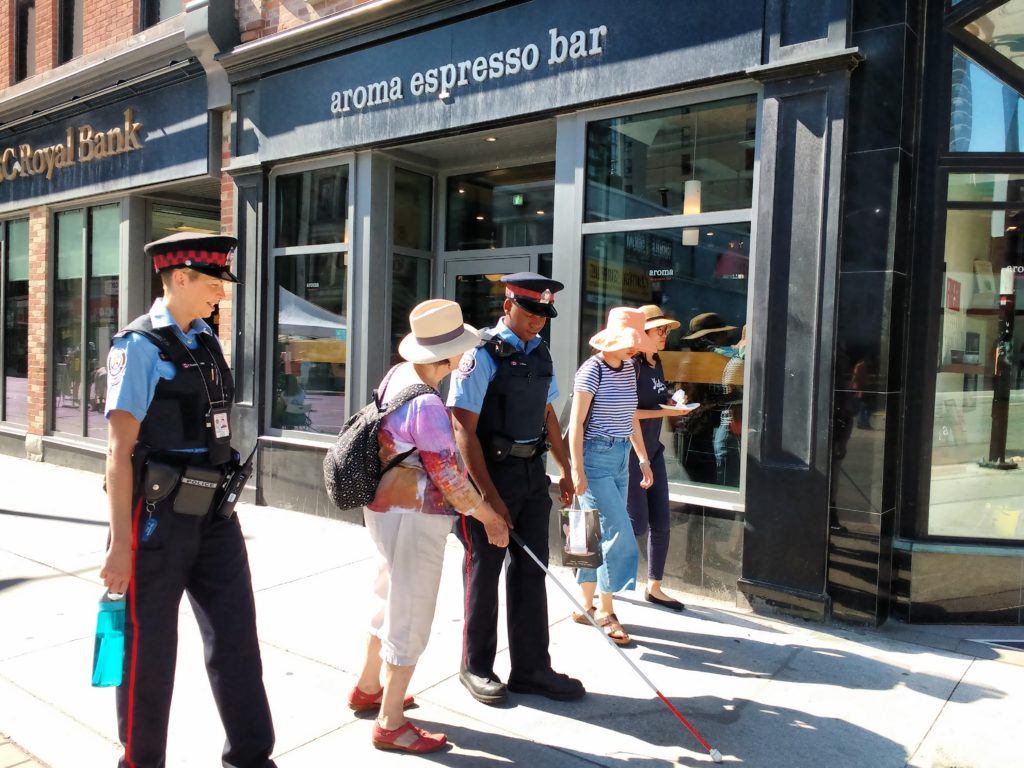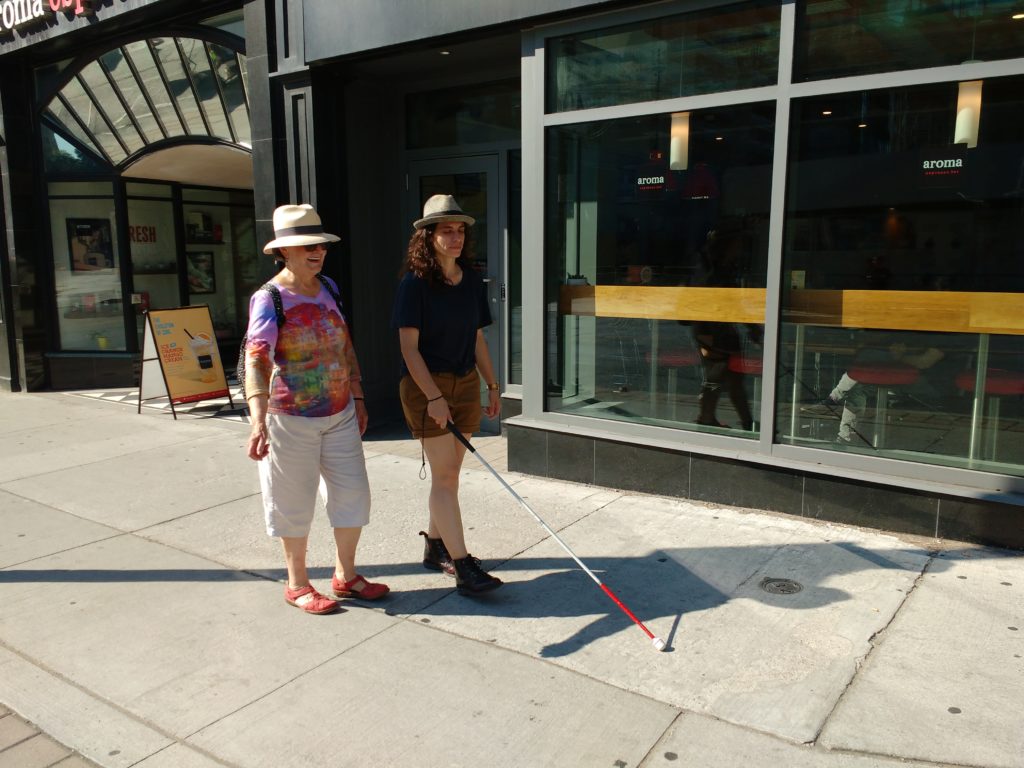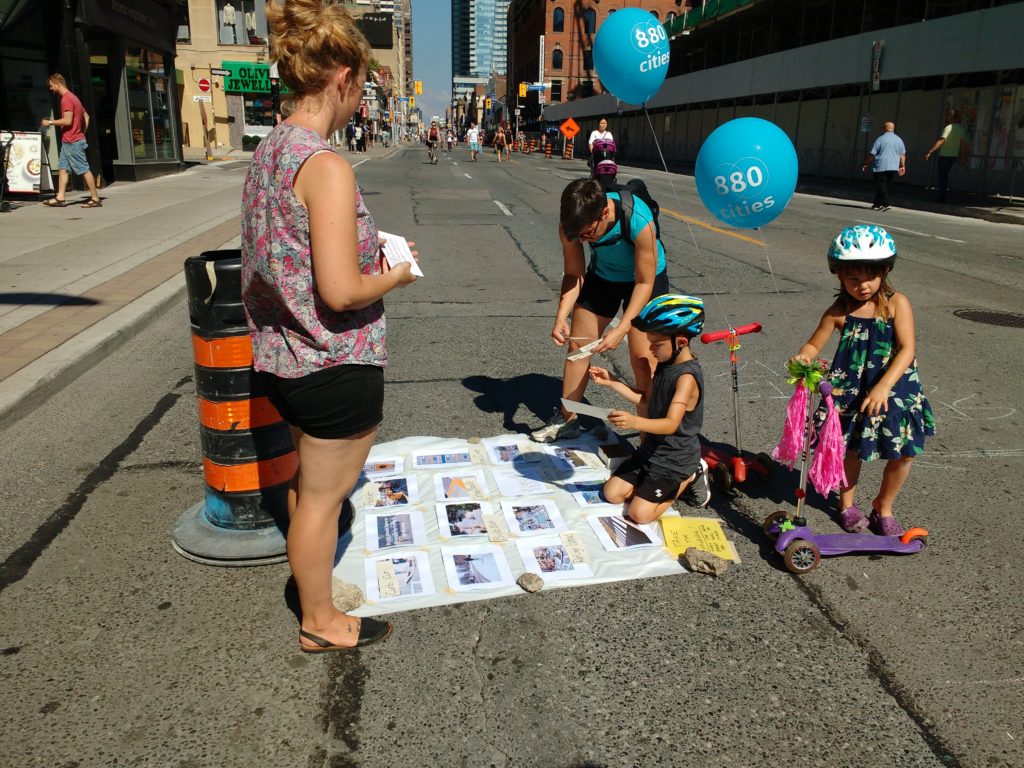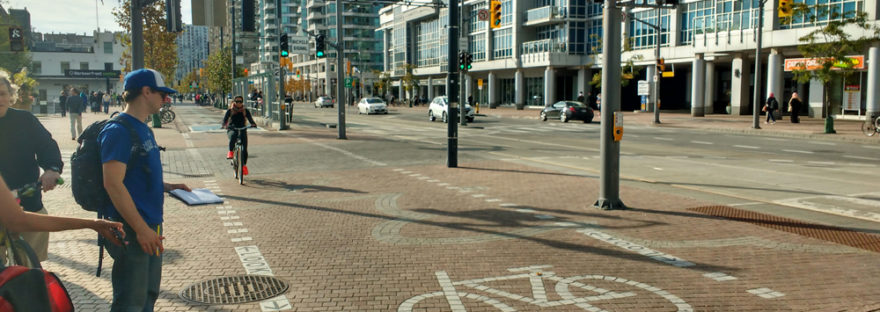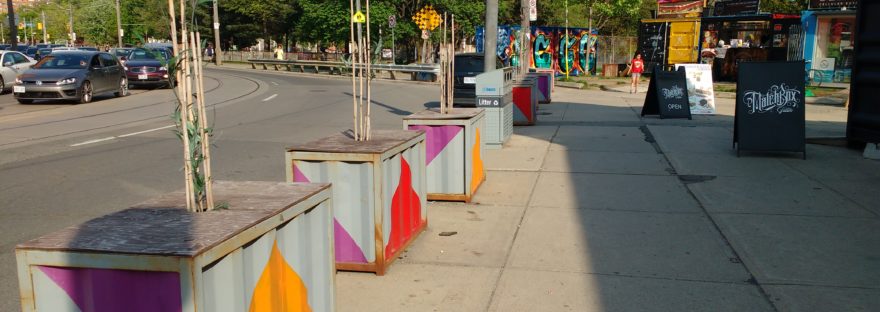By Daniella Levy-Pinto
I am a pedestrian and also totally blind. Road safety literature, signage and campaigns urge pedestrians to make eye contact with drivers before crossing the street. People like me can neither make eye contact to communicate or negotiate a street crossing nor watch for inattentive drivers who may not have seen us in the crosswalk. I do everything in my control to stay safe, but there is a limit to what I can do to protect myself if drivers are distracted; my safety and that of other people depends on drivers following the rules and yielding to pedestrians, especially to those who have the right of way.
Pedestrian safety in Toronto
The growing number of pedestrian deaths in Toronto led City Council to approve the Vision Zero Road Safety Plan in July of 2016, with the goal of reducing traffic deaths to zero by 2021. The rate of pedestrian and cyclist deaths, however, has not dropped: in June 2018, two years after Mayor Tory announced the plan, 93 pedestrians and cyclists had been killed in traffic collisions.
Vision Zero, developed in Sweden, is an approach to road safety that stresses that fatalities and serious injuries in traffic collisions are preventable, and that road design, rather than individual behaviour, is necessary to mitigate the dangerous consequences of human error. In Toronto, the implementation of infrastructure changes required as part of Vision Zero has been slow, notably as a result of concerns about the impact that measures such as reducing speed limits and narrowing traffic lanes may have on commute times for cars, as well as the small budget allocated to implement infrastructure changes.
For the growing number of baby boomers who experience vision loss and can no longer drive, walking becomes indispensable to maintain their independence. Negotiating street crossings in Toronto, however, can be challenging for everyone. Notably, the majority of fatalities are people 65 years and older.
How do blind people cross the street?
People who are blind or have a visual impairment face significant challenges to get around independently; they are exposed to increased collision risk, as are children and seniors.
I am completely blind and get around with my guide dog. To cross a street, my dog stops near the corner; if there is an Accessible Pedestrian Signal (APS,) he finds the pole so that I can press the button to trigger the audible signal and we position ourselves near the crosswalk. If there is no APS, I listen to the flow of traffic, sometimes for more than one traffic light cycle, to decide when it may be appropriate or safe to cross, relying on the surge of parallel traffic as an auditory key. Before I step on the road, I stretch my right arm out and point with my index finger, to indicate my intention to cross; and I stop and listen for potential cars coming in my direction. I am very cautious: I go out of my way to cross at intersections that have an APS and avoid places that I know are dangerous and difficult to cross, and where I feel that the risk is too high. I know that drivers may not stop for me even if I have the right of way; there have been several instances in which cars didn’t stop while I was on the crosswalk at a stop sign; fortunately, my guide dog pulled me back in such occasions.
Traffic safety tips
Road safety literature and campaigns issued by industry and governments urge pedestrians to make eye contact. For example, an insurance company recommends pedestrians to be sure to make eye contact with drivers before crossing the street; and to be extra cautious when boarding or exiting the bus or streetcar, as cars may not stop as they are required. Other industry recommendations for pedestrians also prioritize motorists and discriminate against blind people, including advice to watch for drivers turning left or right through the crosswalk, as they “may be focused on oncoming traffic instead of scanning for you” and of course, to make eye contact with drivers and “never assume that a driver sees you.”
Similarly, recommendations in the City of Toronto’s website include making eye contact with drivers before moving past them. According to Toronto Police it is up to both drivers and pedestrians to keep everyone safe on Toronto roads. They specify that pedestrians should always attempt to make eye contact with oncoming drivers and cyclists before proceeding across their path, especially vehicles that are intending to turn. In January 2018, three out of four online videos released during a one-week safety blitz launched by Toronto police focused on pedestrian behaviour. Nevertheless, it is misleading to brand education measures as components of Vision Zero.
This emphasis shifts the responsibility to the most vulnerable and contributes to victim blaming. In general conversations about road safety, people commonly focus on the role of vulnerable road users themselves to stay safe when crossing. Common arguments include that pedestrians should pay attention to their safety; that careless pedestrians put themselves in danger by being distracted; and, of course, that people must make eye contact.
These messages, however, misdirect attention to the victim, disregard that some people are not able to make eye contact or to look out for bad drivers, and discriminate against pedestrians with visual impairments. When I read this kind of advice, I feel that, as a pedestrian who is blind, I can never cross the street safely. It does not make sense that vulnerable road users who have the right of way are expected to watch for vehicles, such as when motorists turn right on a red light. What is the point of having the right of way as a pedestrian, then? Of course, one should pay attention and be cautious, but there is a limit to what vulnerable road users can do to protect themselves from drivers who do not obey traffic rules or who are distracted.
Moreover, the emphasis on shared responsibility creates wide generalizations about pedestrian behaviour that are not helpful to address the main causes for fatalities and serious injuries resulting from collisions with motor vehicles: road design and distracted driving. A 2015 report from Toronto Public Health that examined vehicle-pedestrian injuries between 2008 and 2012 found that in 67% of cases, the person who was struck had the right of way; only 19% of the time were the pedestrians crossing without the right of way, and the other 14% could not be determined. In a survey conducted by RSA Canada that included 346 respondents from the GTA, Toronto’s pedestrians, cyclists and drivers all identified drivers as a major cause of distress on the roads: 67% of pedestrians and 67% of cyclists cited drivers not following rules and 74% of drivers identified distracted drivers as a concern for them.
The notion that eye contact is an essential element for crossing the street discriminates against the most vulnerable road users, namely people who are blind, children or seniors, many of whom have age-related visual impairments: children may have perfect eyesight, but may not be tall enough to make eye contact with someone in a higher vehicle, or they may not understand that they are expected to negotiate a street crossing when they have the right of way; people with autism or other neurological disorders may not feel comfortable making eye contact; seniors using a mobility devise such as a walker may need to focus on the crosswalk ahead rather than on making eye contact. Even sighted pedestrians may not be able to make eye contact with drivers inside vehicles with tinted windows. All these groups of people should be able to trust that drivers will stay focused on the road and follow the law that requires them to yield to pedestrians who have the right of way.
As a pedestrian who happens to be blind, I am concerned about the emphasis on making eye contact to negotiate street crossings: it could arguably make drivers less cautious if they rely on pedestrians to communicate their intention to cross in that way. As well, it is possible that if a motorist strikes someone and the case ends in court, they could blame the pedestrian for not making eye contact to communicate.
Shared responsibility?
The expectation that pedestrians make eye contact with motorists before crossing the road is a reflection of car-centric culture and policies that since the mid-Twentieth Century have prioritized cars over all other forms of transportation. In the 1920s and 1930s, as automobiles became common, drivers were blamed for pedestrian deaths. The responses to pedestrian fatalities included traffic rules to slow cars down and proposals to restrict cars mechanically. This worried automotive interest groups, sometimes called “motordom,” who organized to shift the blame for pedestrian fatalities to pedestrians themselves. By the 1930s, dedicated lobbying by motor interests was changing perceptions about street users: automobiles, previously considered as dangerous intruders on city streets, began to be seen as the primary users of the road and pedestrians were expected to take some share of responsibility for their safety. By the 1950s, the perception that city streets were the domain of motor vehicles became widespread across North America. Expecting pedestrians to make eye contact and watch for drivers is another example of how the growth of the car industry further restricted the right to free mobility of those outside motor vehicles.
Framing road safety as a matter of responsibility that is equally shared among all users fails to recognize the differences among all modes of transportation. Motorized vehicles pose a significant risk to those who are outside of them. Pedestrians have no protection against the speed and mass of moving vehicles. When vulnerable road users are involved in collisions with motorized vehicles, they are likely to suffer severe consequences because they are not protected by a ton of metal and by safety features, such as seatbelts and airbags. Motorists have the most responsibility to follow safety rules and be cautious because they have the largest capacity to cause harm to others.
The level of responsibility of different road users should be proportional to the damage they can cause. Streets belong to everyone, not only to those behind the wheel. Encouraging people to make eye contact puts a disproportional burden on vulnerable road users to protect themselves from the errors of inattentive or aggressive drivers, and discriminates against those who cannot make eye contact.
A shift in culture and bold policies that prioritize the safety of vulnerable road users above convenience or rapid traffic flows are good for everyone, including drivers: when people feel safe, they are more likely to engage in some form of active transportation, and that, in turn, reduces vehicular congestion. Everyone, regardless of age or ability, should be able to cross the street safely.
Daniella Levy-Pinto is a member of Walk Toronto’s steering committee




